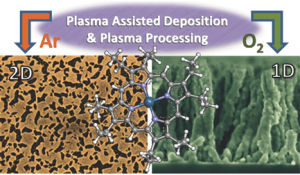Alejandro Nicolas Filippin, Juan Ramon Sanchez-Valencia, Jesús Idígoras, Manuel Macias-Montero, Maria Alcaire, Francisco Javier Aparicio, Juan Pedro Espinos, Carmen Lopez-Santos, Fabian Frutos, Angel Barranco, Juan Antonio Anta, Ana Borras
Advanced Materials Interfaces 4 (2017) 1601233

This article establishes the bases for a vacuum and plasma supported methodology for the fabrication at mild temperatures of nanostructured platinum in the form of porous layers and nanocolumns using platinum octaethylporphyrin as precursor. In addition, the application of these materials as tunable optical filters and nano-counterelectrodes is proved. On one hand, the transparency in the ultraviolet–visible–near infrared range can be adjusted precisely between 70% and 1% by tuning the deposition and processing conditions, obtaining a high spectral planarity. Deviations of the spectra from an ideal flat filter are below 4%, paving the way to the fabrication of neutral density filters. The transparency limit values yield a sheet resistivity of ≈1350 and 120 Ω −1, respectively. On the other hand, the catalytic properties of the nanostructures are further demonstrated by their implementation as counterelectrodes of excitonic solar cells surpassing the performance of commercial platinum as counterelectrode in a 20% of the overall cell efficiency due to simultaneous enhancement of short-circuit photocurrent and open-circuit photovoltage. One of the most interesting features of the developed methodology is its straightforward application to other metal porphyrins and phthalocyanines readily sublimable under mild vacuum and temperature conditions.

